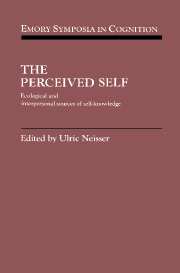Book contents
- Frontmatter
- Contents
- Preface
- List of contributors
- Part I Introduction
- Part II The concept of an ecological self
- 2 Ontogenesis of the perceived self
- 3 Body–environment coupling
- 4 A theory of representation-driven actions
- 5 The ecological self in historical context
- 6 Good intentions and dancing moments: Agency, freedom, and self-knowledge in dance
- 7 The primacy of the ecological self
- Part III The interpersonal self and its implications
- Author index
- Subject index
2 - Ontogenesis of the perceived self
Published online by Cambridge University Press: 29 March 2010
- Frontmatter
- Contents
- Preface
- List of contributors
- Part I Introduction
- Part II The concept of an ecological self
- 2 Ontogenesis of the perceived self
- 3 Body–environment coupling
- 4 A theory of representation-driven actions
- 5 The ecological self in historical context
- 6 Good intentions and dancing moments: Agency, freedom, and self-knowledge in dance
- 7 The primacy of the ecological self
- Part III The interpersonal self and its implications
- Author index
- Subject index
Summary
To perceive the world is to coperceive oneself.
J. J. Gibson“The stage is set, enter the hero of the play… We take a new step, long deferred and often anticipated, and introduce the Ego” (Koffka, 1935, p. 319). So begins the second half of a book that played an important role in my early education as a psychologist. This was Kurt Koffka's way of introducing his treatment of action. The ego he considered a field object, segregated from other objects, and also the “executive” in control of behavior.
There are many other ways of discussing the ego (see Neisser, 1988). I am going to refer to the “self,” as Neisser did, rather than the ego, because the term carries less literary and moral baggage. My aim is to show the way in which the self is rooted in perception. “You” are an object in a world of other objects, and I perceive you as such. So, indeed, am “I,” and just as surely I perceive myself as an object in the same world of things and events that I locate you in.
- Type
- Chapter
- Information
- The Perceived SelfEcological and Interpersonal Sources of Self Knowledge, pp. 25 - 42Publisher: Cambridge University PressPrint publication year: 1994
- 1
- Cited by



